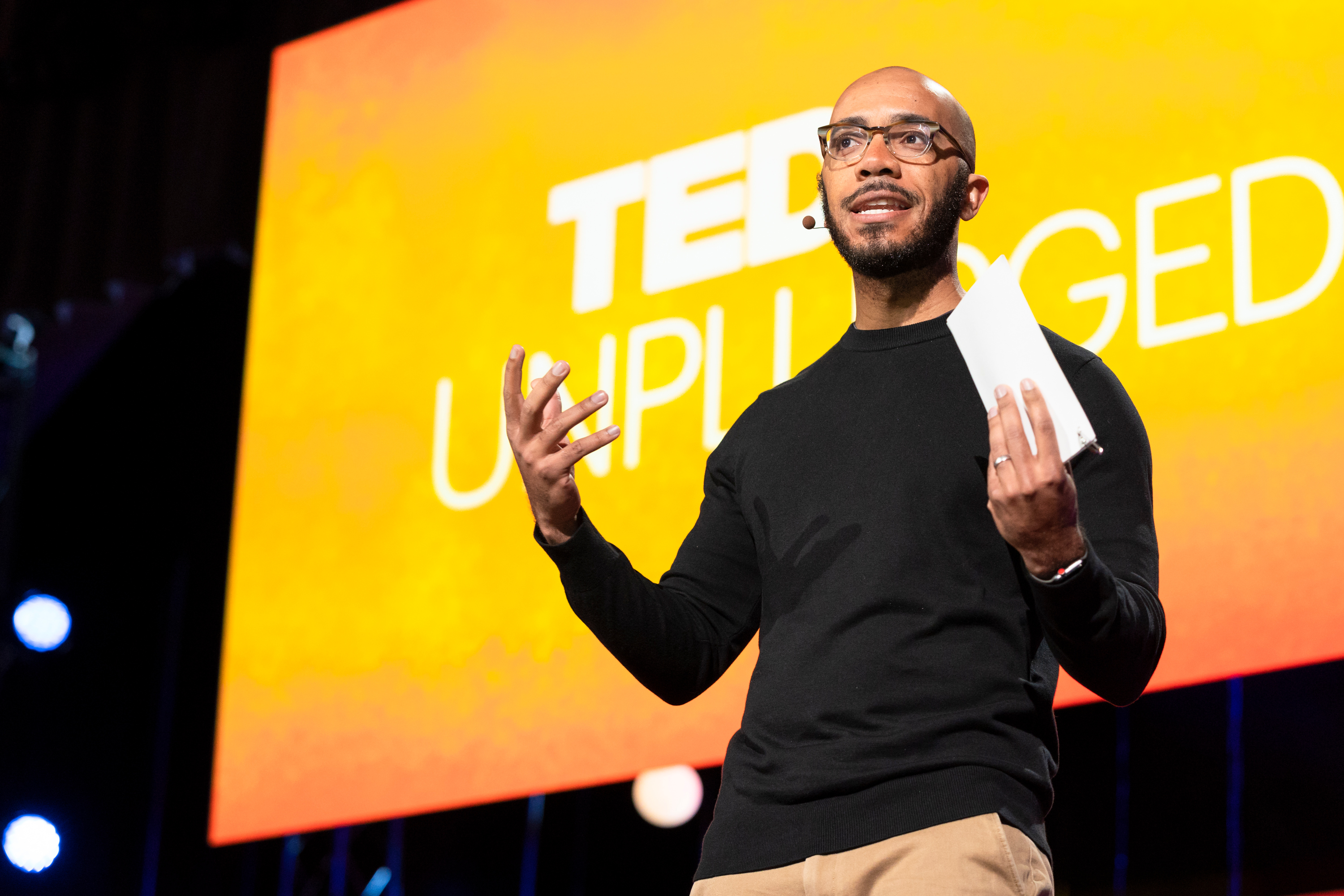
Host Clint Smith welcomes us all to the Unplugged session at TED2018, April 11, 2018. Photo: Ryan Lash / TED
“This is a little different than the mainstage at TED, in a sense that this is a little more relaxed,” says our host, the poet and TED speaker Clint Smith. “These are speakers who have not been selected specifically for the mainstage, but they’re just as talented, just as brilliant, and just as important.”
A spectrum of ideas, stories, perspectives and insights hit the TED Unplugged stage on Wednesday afternoon. Thirteen speakers put their best talks forward in a playful, abbreviated version of TED Talks, in six minutes with timed slides, delivered to a packed audience full of energy and anticipation (and fueled by doughnuts).
Hacking romance. Let’s face it, online dating can suck. So many potential people, so much time wasted … is it even really worth it? Christina Wallace thinks so, if you do it right. Treat it sort of like a résumé review, she advises, and use sites or apps that emphasize the criteria you’re looking for. For example, she used OKCupid because she wanted to avoid the gamification of swipe-based apps (and also, she wanted a writing sample). Most important, try out her zero-date approach: go out with a person for one hour, have one drink, while asking yourself one question — would I like to have dinner with this person? Simple, super efficient (you could potentially fit three in one evening), and if the zero-date’s awesome, then you schedule an actual date. It worked for her, and if you’re looking for someone, it can serve you too — just don’t treat it like a game. “The point of this isn’t swiping,” she says. “It’s finding your person. Good luck.” Watch Christina Wallace’s talk: “How to stop swiping and find your person.”
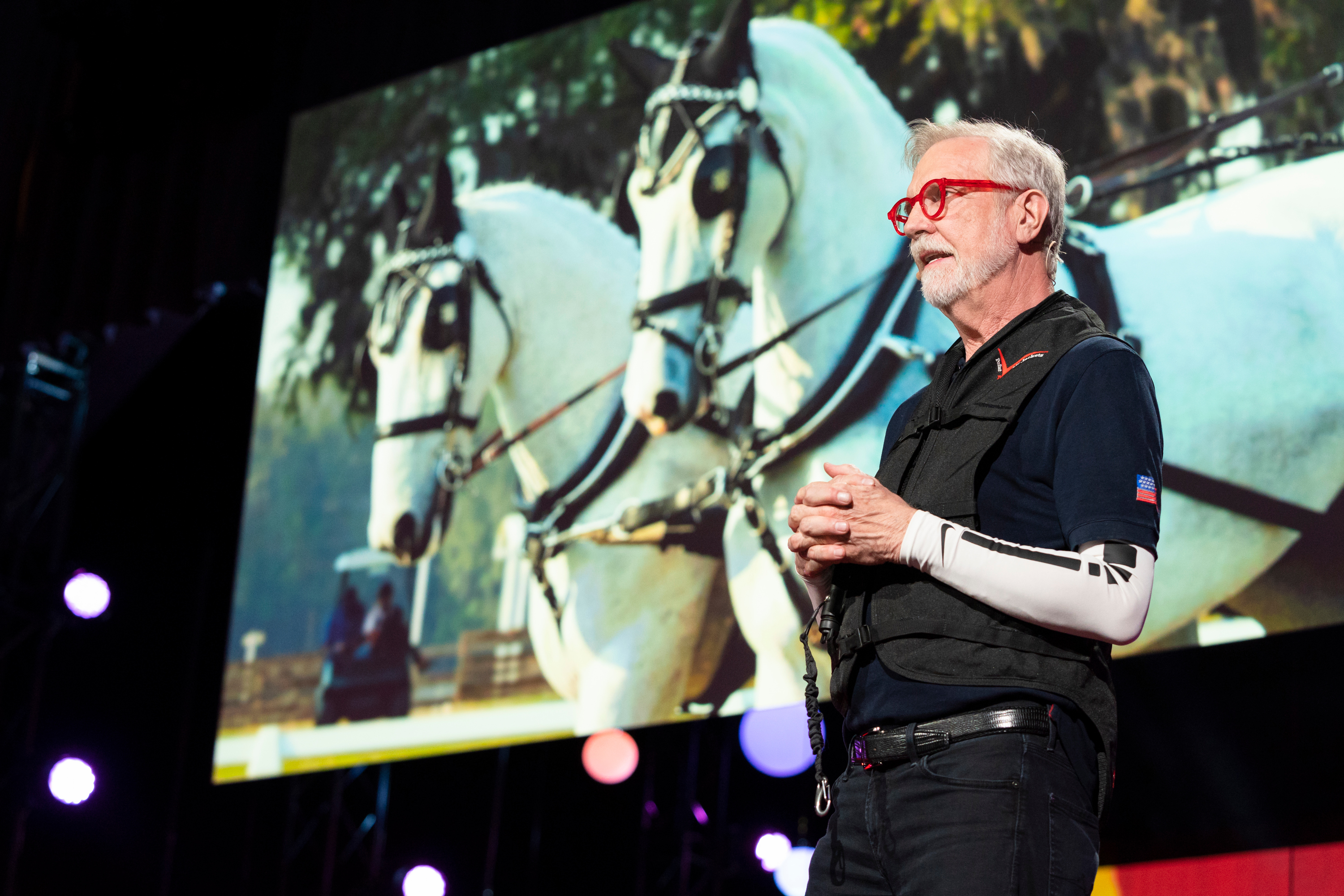
Steve Wilson is a champion in Combined Driving, an three-day equestrian sport that requires some new kinds of problem-solving. Photo: Ryan Lash / TED
Dances with horses. Steve Wilson horses around quite a bit — so much so that at 70 years old, he’s become the American National Champion in an equestrian field at the Olympic level for three years running. He competes in Combined Driving, a three-day sport that tests athletes on their ability to drive a carriage pulled by one, two or four horses. Each day comes with a new set of challenges: first dressage, then a marathon race, and finally a test of swift accuracy. For Wilson, whose eyesight has deteriorated to the point of legal blindness, he encounters the extra challenge of needing to learn the course in order to compete. He solves the problem by walking the paths for 11 miles each day until he has them committed to memory. “With steadfast determination,” he says, “the impossible is possible.”
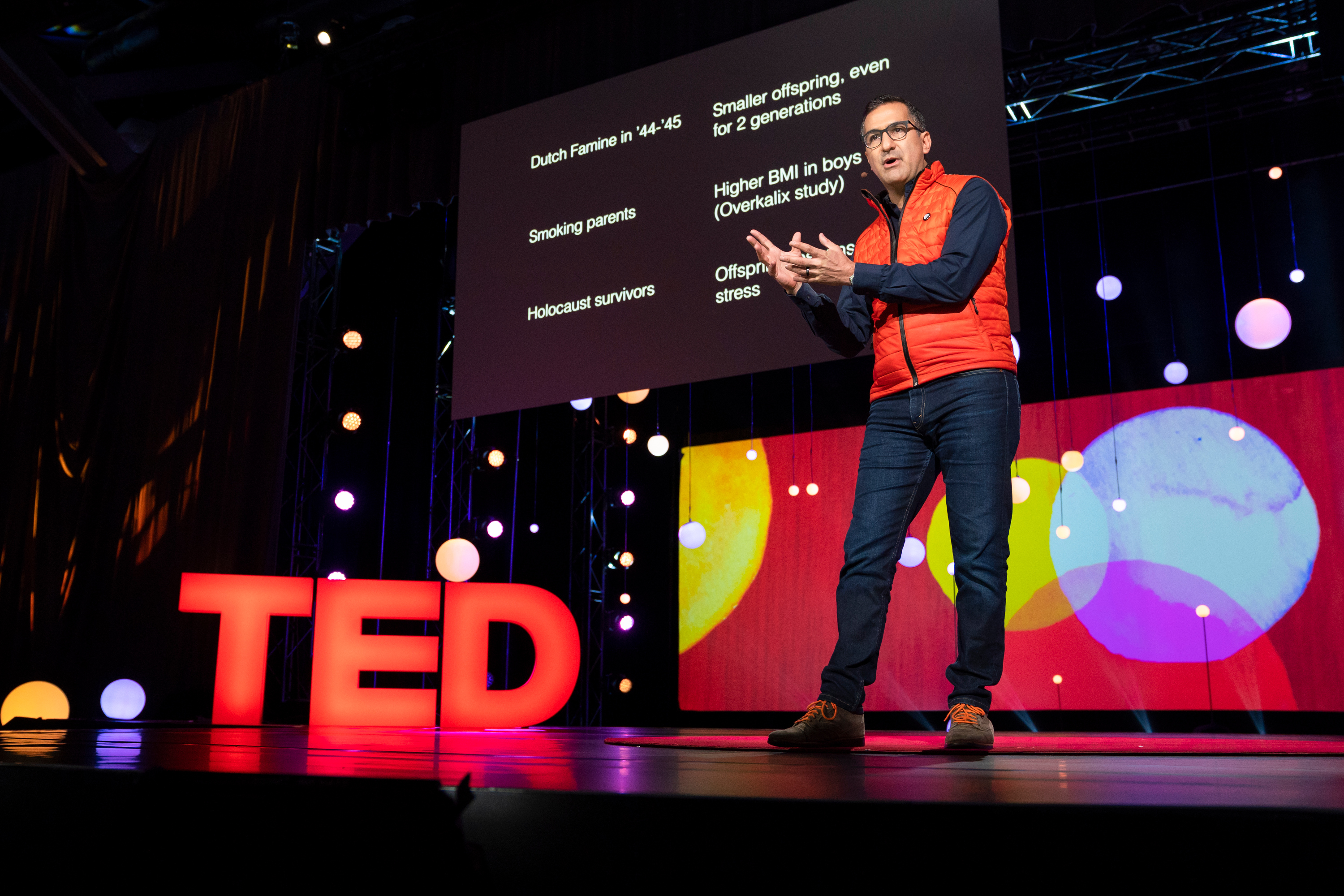
Rodrigo Martinez explores epigenetics — the new (old) science of figuring out exactly what we inherit from our parents and ancestors. Photo: Ryan Lash / TED
Past lives of the deep. Rodrigo Martinez often dives deep into the underworld, a quiet place where the Mayans believed gods and goddesses lived, and life and death blurred. He does this all in a single breath, held for just over five minutes as he descends about 100 feet to the bottom of a cenote (a natural pit that gives way to groundwater). To him, it feels as if he’s entered a different dimension, that he’s connected with something old and natural, humbling and beautiful, while he hovers in calm blue waters. But what if this isn’t the first time this feeling has been experienced? As Martinez shares, different experiments in epigenetics and neurobiology show that this may be the case — that like stressors, positive experiences and feelings could be inherited from our ancestors through specific molecular switches, like an echo of the past. We may be scratching the surface of something fascinating in science, that could connect us all in new, fascinating ways.
Rediagnosing failure. When almost everything in Lisa Genova’s life seemed to be falling apart, a few other things began shifting into place. She was a neuroscientist who wanted to write a novel (eventually), but there seemed no other time than now to start. And yet, she felt stuck and uncertain of the future. So she asked herself three questions: If I could do anything I wanted, what would I do? If I didn’t have to care about what anyone thought of me, what would I do? and if I didn’t have to worry about money, what would I do? Each question eventually led to the same answer — write the novel. Inspired to craft a story from a humanizing perspective of people living with neurological diseases and disorders, like her grandmother, she began writing a story about a woman with Alzheimer’s. After many months of selling her self-published book out of the trunk of her car, Genova sold her book to Simon & Schuster, and Still Alice continues to make waves and invite global conversation to this day. She asks: “What if you could let go of all limitations and allow yourself to do anything you want to do — what would you do?” (You can watch Lisa’s TED Talk here.)
A new lens on cities. Have you ever taken a closer look at the east sides of cities? (Think about places like East Orange, New Jersey; East Oakland, California; East London, United Kingdom; and even East Jerusalem.) More often than not, you may note that these sections often house more marginalized communities. They’re not the “nice” side of town. But why? Stephen DeBerry asked the same question and surfaced fascinating answers (the wind) alongside unsurprising culprits (humans). The Earth rotates counterclockwise, creating a wind that generally blows in the eastern direction, which was more or less a fun fact until the industrial era, when locomotives would cut through towns and cities spreading soot and smog — which would be carried on the eastern winds and into neighborhoods. Guess who got redlined into those neighborhoods: disenfranchised people. “The wrong side of the tracks” is a disparaging phrase as much as it is a slogan for disparity by design, a sinister decision-making that leads to the devastating effects of carving up a city based on bias and privilege. Elegant solutions to bad design can drive policy change and philanthropy, but we must be cognizant of what we’re designing for. “We got ourselves into this east side dilemma through bad design, so we can get out of it with good design” DeBerry says. “I believe the first principle of good design is actually really simple: We have to start with the commitment to design for the benefit for everyone.” Watch Stephen DeBerry’s talk: “Why the “wrong side of the tracks” is usually the east side of cities.”
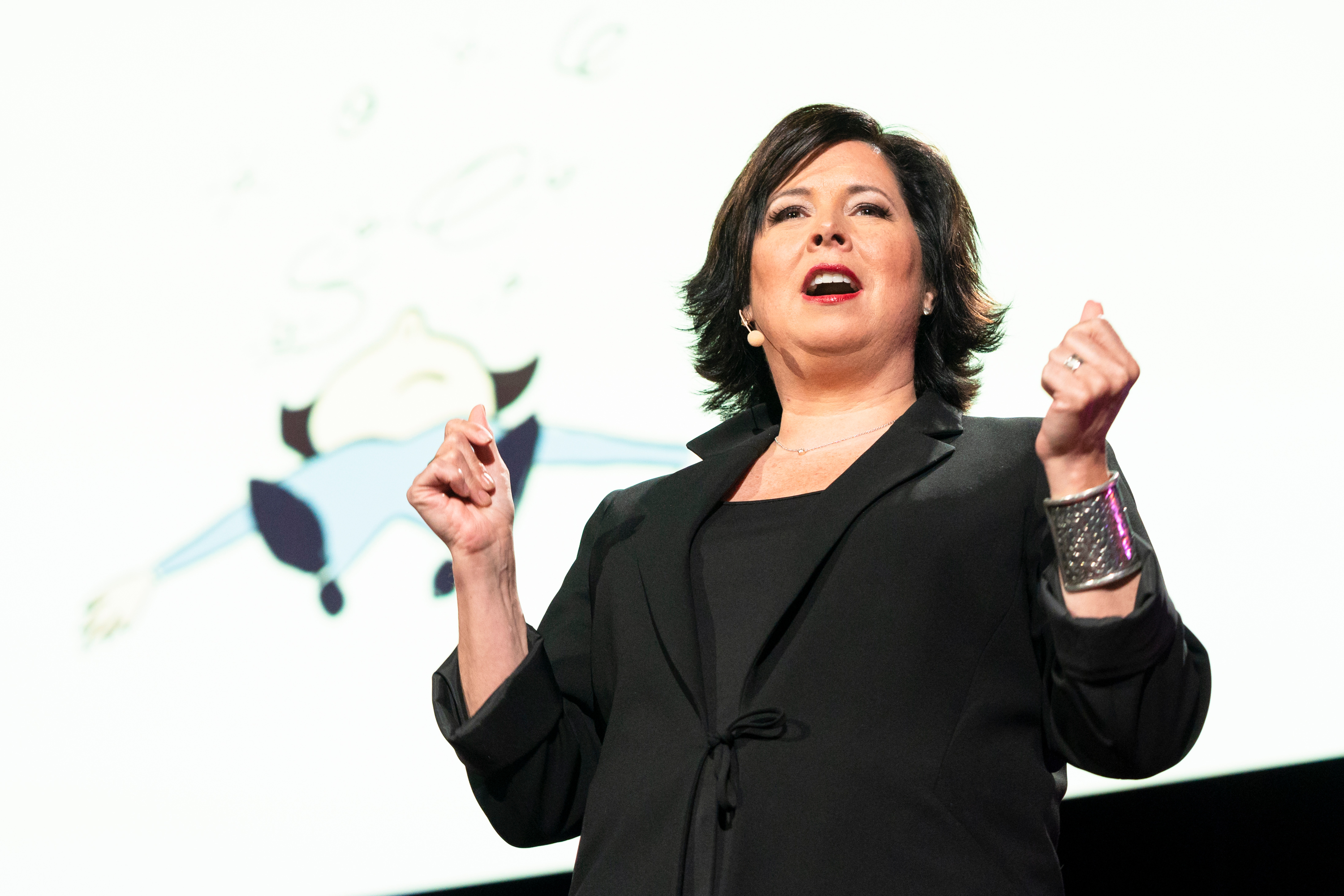
How does futurist Sheryl Connelly think about her job? As a “polite contrarian,” someone who asks others to re-examine their assumptions. Photo: Ryan Lash / TED
Confessions of a futurist. Sheryl Connelly has a confession: As a professional futurist, she can’t actually predict the future. Perhaps for accuracy, she pondered on stage, she should rebrand her title as a “polite contrarian” — because what she really does is challenge deeply rooted assumptions and constantly push against the status quo. No one can predict the future, she says — no, not even tarot card readers — but we do it every day by making decisions based on how we think the future will unfold. “I’m a firm believer that the only way to truly predict the future is to create it, but that will never happen unless you become mindful of things you can’t control or influence, become aware of the way the world is changing around you, and be more aware of the consequences these changes can bring,” she says. “If you learn to live in the realm of uncertainty, you will awaken to a spectrum of possibilities that are new and extraordinary.”
A search engine for the Earth. 21 rocket launches later, with more than 200 satellites in orbit and 31 ground stations across the world, TED speaker Will Marshall can definitely say mission accomplished. As CEO and co-founder of Planet, Marshall’s company has the unique distinction of keeping a constant bird’s-eye view on Earth’s changing landscapes. But he’s moved onto his next big mission: using artificial intelligence to index everything within each image (trees, planes, ships, etc.) and making it searchable — or as he calls it “Queryable Earth.” He shared a vision of this database becoming a living almanac of physical change on Earth, documenting immense change of our planet for the Information Age. He says: “You can’t fix what what you can’t see and we wanted to give people the tools to take action.” As a bonus, he launches from stage a brand-new product aimed at everyday people, letting us play with satellite images. Create an account on Planet Stories to get a new view on our planet. Watch Will Marshall’s latest talk: “The mission to create a searchable database of Earth’s surface.”
The upside of calamity. TED speaker Catherine Mohr is not entirely human and has a perilous tale as to why. So, she was scuba diving through a school of sharks, when a clutch of sea urchin spines pierced her hand right through her glove. Mohr lived to tell her tale after boiling said hand to cleanse it of toxins, only to later learn that a piece of sea urchin spine broke off inside her finger joint and needed to be removed. A week before that surgery, she broke her pelvis falling off a horse. During the healing process from that surgery, as she sat immobile on her couch for weeks, one particular friend kept showing up, dependably, day after day to keep her fed and entertained. Reader, she married him. And meanwhile, she discovered that the sea urchin spine had been metabolized by her body, as it scavenged for calcium to repair her shattered pelvis. She jokes that not being fully human is one of the reasons her family loves her — but she wouldn’t be with them if it wasn’t for a dash of disaster and distress. (And shout out to Catherine’s teenage daughter, who designed her mother’s wonderful and charming slides!) Watch Catherine Mohr’s new talk: “How I became part sea urchin.”
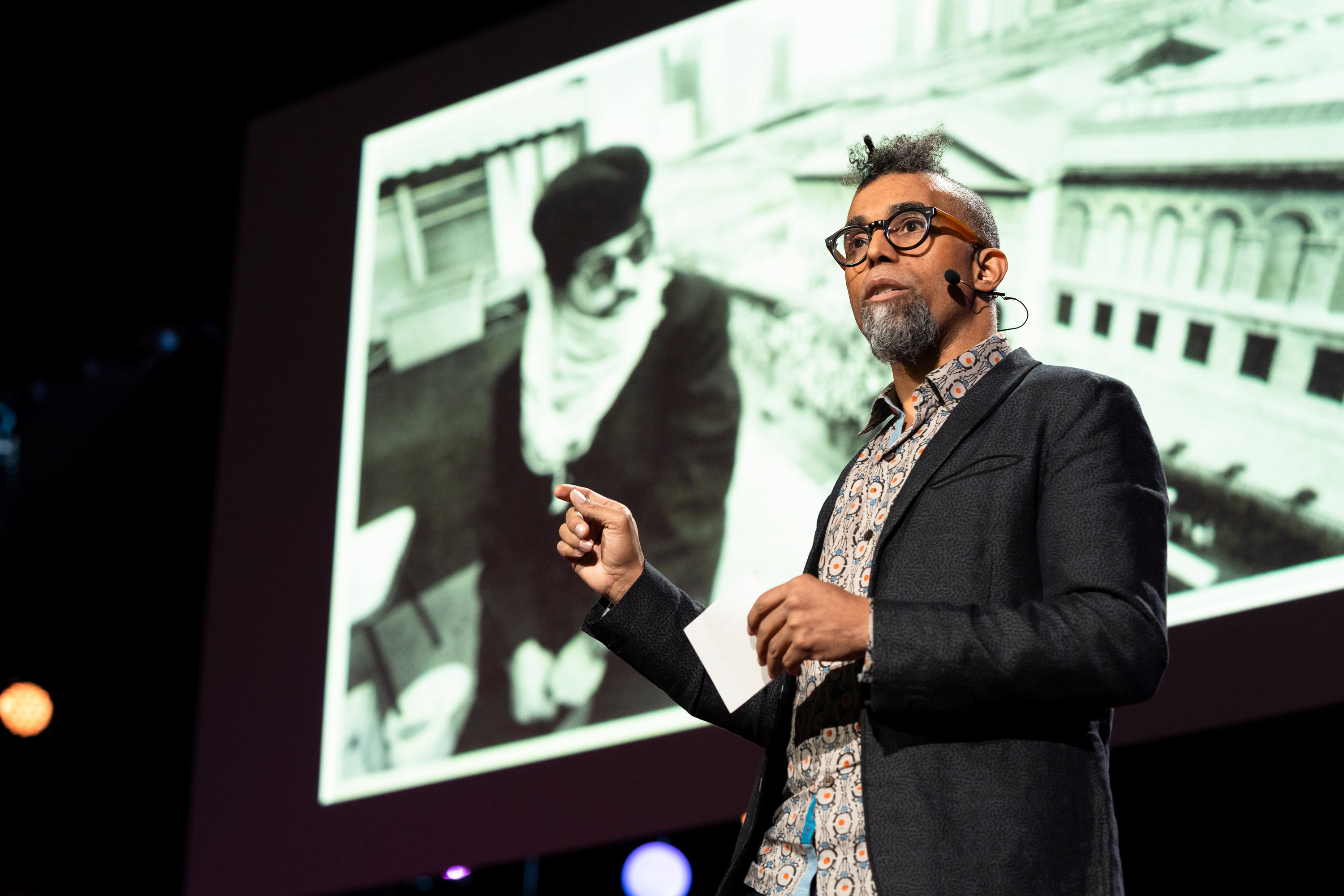
Artist Dread Scott tells the story that leads up to this archival photo of himself, sitting on a rooftop across from the Chicago Art Institute as a crowd below protests his challenging work, a protest that worked all the way up to the Supreme Court. Photo: Ryan Lash / TED
The art of protest. Visual artist Dread Scott makes revolutionary art to propel history forward. His work subverts the socioeconomic and governmental foundations of the United States and encourages audiences to address big questions from that perspective. Scott shared the engrossing story behind one of his most transgressive art installations, “What Is the Proper Way to Hang an American Flag?” In 1989, the piece drew national attention for its controversial use of the American flag, which gave people the option to stand on the flag. Scott received numerous death threats — many evoking images of lynching — for his work and notoriety among politicians of the time (e.g. President George Bush Sr. and Senator Bob Dole). The installation was outlawed by Congress, which then involved Scott in a landmark First Amendment case that prevented the government from demanding patriotism be mandatory. Watch Dread Scott’s TED Talk: “How art can shape America’s conversation about freedom”
Hunches from a poker pro. “Like poker, life is also a game of skill and luck,” says professional poker player Liv Boeree. She has learned a lot from poker and on the TED Unplugged stage she shares what poker has taught her about decision-making in everyday life: Check your ego, train yourself to think in numbers and probability, and don’t rely too heavily on your intuition. “Why should we assume our intuitions are better calibrated than slow, proper analysis? They don’t have any data to be based off!” Watch Liv Boeree’s TED Talk: “3 lessons on decision-making from a poker champion”
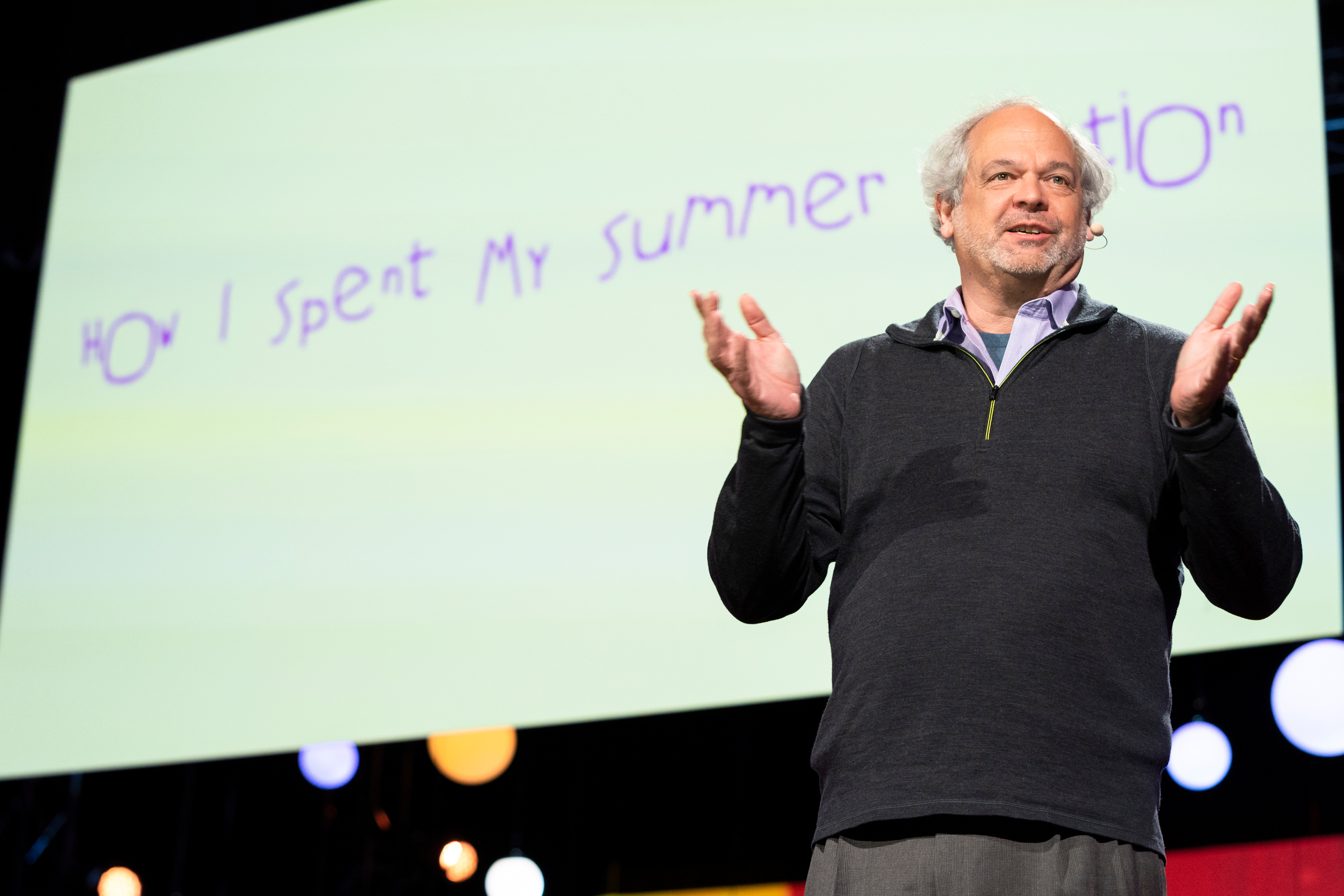
Never stop writing your “how I spent my summer” essays, suggests Juan Enriquez, whose own life demonstrates the benefits of being always on the lookout for the most interesting possible thing to do. Photo: Ryan Lash / TED
Cruising for science. One random New Years’ Eve, prolific TED speaker and futurist Juan Enriquez sat down next to an obscure scientist and chatted for three hours. (Just a note, this “obscure scientist” was Craig Venter, who ended up sequencing the human genome.) Three weeks after meeting, they sailed across the Atlantic together on a trip that would change the course of their lives and eventually the direction of science itself. Years later, the two decided take another sailing trip — this time, across the Pacific (then the rest of the world) to study the genome across the planet. That expedition and the many that followed led to a series of new ideas, such as understanding the microbiome and developing programmable cells to create synthetic life. However, Enriquez’s takeaway is much simpler than the science he studies: he urges people to reflect on their accomplishments and think about how they reinvent themselves going forward. In other words, never stop writing that “how I spent my summer” essay … and live to write better and better ones.
The language of data. It may go without saying, but the founder of infographics.com, Tommy McCall, loves infographics. On the TED Unplugged stage, he waxed poetic about the many ways quantitative information can be communicated and transformed into transfixing chartforms. A combination of love letter and history lesson, McCall shared fascinating data sculpted into beautiful shapes, from historic charts like Florence Nightingale’s coxcomb chart and Charles Maynard’s epic combination of chart and maps to display Napoleon’s journey into Russia, to way-new graphs he’s made for business and science magazine (and some for fun). Tracing humanity’s vehicles for language from orality and literacy, to numeracy and now graphicacy, McCall makes a point that thousands of data points can also be works of art. Watch Tommy McCall’s TED Talk: “The simple genius of a good graphic.”
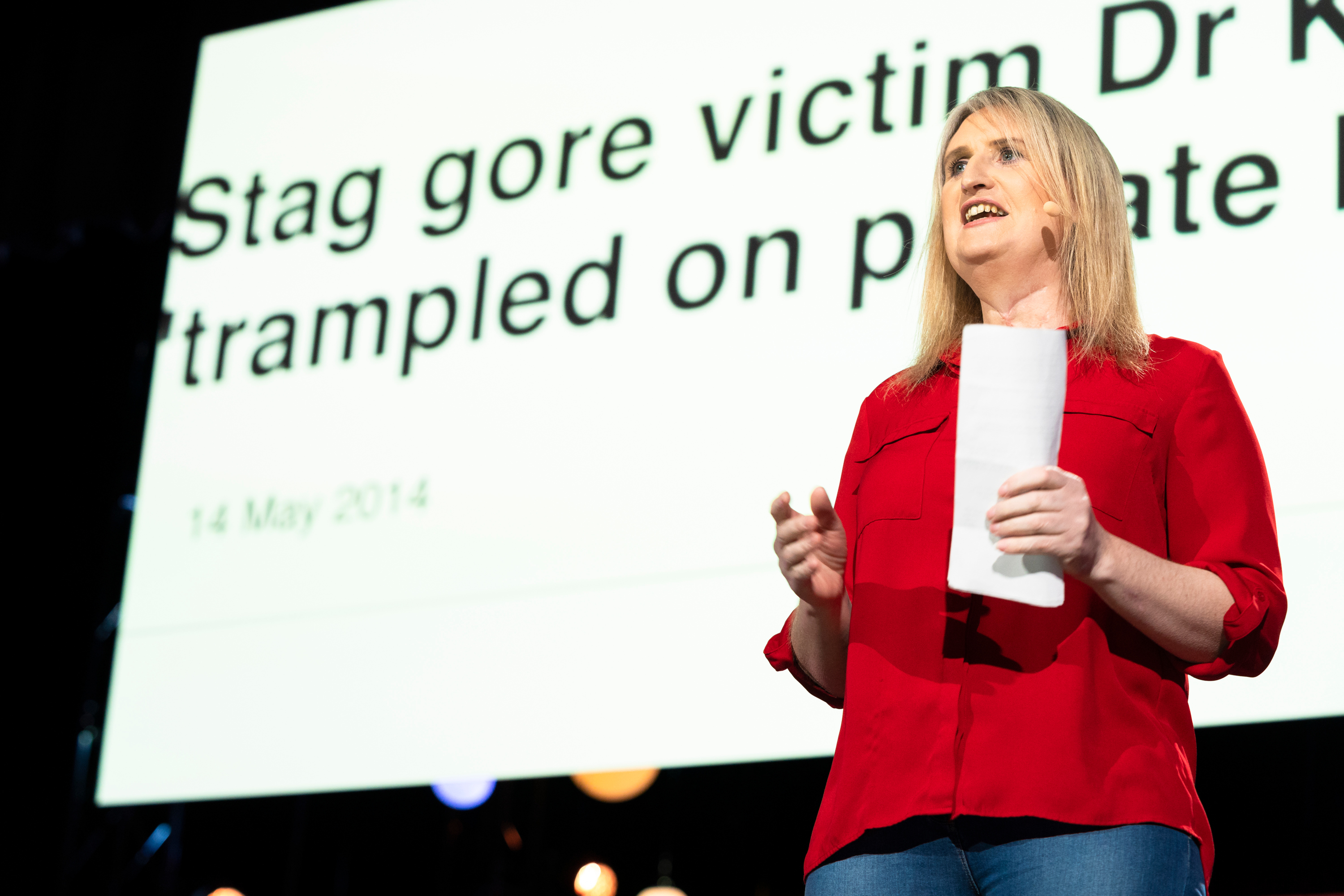
After a freak accident put her in the headlines, Dr. Kate Stone found a way to reclaim her story — and help prevent other people from losing their privacy. Photo: Ryan Lash / TED
What I learned when I lost my privacy. TED speaker Kate Stone closed out the session with a tough personal tale infused with humor and integrity. As she left a pub one evening, Kate felt a hard thump, was knocked to the ground, and woke up unable to breathe. Shockingly, she had been gored by a stag that had escaped from a nearby pen; the animal’s antler tore through Stone’s throat and fractured her spine. She was airlifted to the nearest hospital, where doctors induced a coma to save her life. While she was under, news outlets covered her story — but some outlets focused not just on the horrific accident, but on her gender as well. “I’m transgender, it’s not that big of a deal,” Stone says. “My hair color or my shoe size is way more interesting.” When she awoke, she was greeted with a slew of derogatory headlines that drove her to reclaim her own narrative, and to ensure that others would not have to endure this same indignity. She wrote to the news outlets and commenced her own media tour. The result: not only did she get the apology she rightly deserved, but in the process she was invited to sit on the journalistic ethics board of the same newspapers that once sensationalized her story. Watch Kate Stone’s TED Talk: “The press trampled on my privacy. Here’s how I took back my story.”